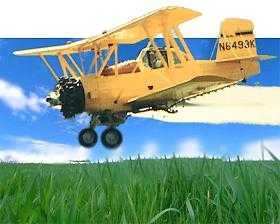Sun, Apr 28, 2024
NAAA Reminds Drone Operators to Yield to Agplanes
As the U.S. agricultural season kicks into high gear, the National Agricultural Aviation Association (NAAA) is calling on both professional and hobbyist drone operators to exercise heightened awareness and caution during their flights.

This appeal aims to mitigate the risks of aerial collisions as low-flying manned agricultural aircraft commence their crucial work over the nation's croplands.
Agricultural aviators are responsible for treating an impressive 127 million acres of U.S. cropland annually. These operations often occur at altitudes as low as 10 feet, at speeds up to 140 mph, making it extremely challenging for pilots to detect and avoid drones, which are typically mandated to fly below 400 feet without specific waivers from the FAA.

Andrew Moore, CEO of NAAA, emphasizes the critical nature of this issue: "It is extremely difficult, if not impossible, for manned aircraft to see a drone while conducting crop-enhancing and other aerial applications at low altitudes and high speeds. We urge drone operators to equip their UAS with detect and avoid technology and to always yield the right of way to manned aircraft to ensure a safe growing season."
The NAAA highlights several guidelines for drone operators to follow:
- Always give right of way to manned aircraft, as required by law.
- Equip drones with visible strobe lights, distinctive markings, and tracking technologies like ADS-B In systems.
- Obtain proper certification and training for safe and effective drone operation.
- Consult local agricultural operations before flight by using resources like the Find An Aerial Applicator database available at AgAviation.org.
- Land drones immediately if a low-flying manned aircraft is spotted nearby.
- Maintain adequate unmanned aircraft liability insurance.
These precautions come in response to an NAAA survey where 11% of agricultural pilots reported encountering a drone during flight operations last year, underscoring the growing concern over safe airspace cohabitation.
The FAA also supports these safety measures and will highlight them during their annual Drone Safety Day, reflecting the ongoing commitment to integrating drones safely into national airspace. As drone registrations and the number of certified remote pilots continue to rise sharply, the importance of conscientious drone operation cannot be overstated.
More News
He Attempted To Restart The Engine Three Times. On The Third Restart Attempt, He Noticed That Flames Were Coming Out From The Right Wing Near The Fuel Cap Analysis: The pilot repor>[...]
Make Sure You NEVER Miss A New Story From Aero-News Network Do you ever feel like you never see posts from a certain person or page on Facebook or Instagram? Here’s how you c>[...]
From 2009 (YouTube Edition): Leading Air Show Performers Give Their Best Advice for Newcomers On December 6th through December 9th, the Paris Las Vegas Hotel hosted over 1,500 air >[...]
Aero Linx: NASA ASRS ASRS captures confidential reports, analyzes the resulting aviation safety data, and disseminates vital information to the aviation community. The ASRS is an i>[...]
“For our inaugural Pylon Racing Seminar in Roswell, we were thrilled to certify 60 pilots across our six closed-course pylon race classes. Not only did this year’s PRS >[...]
 NTSB Final Report: Rutan Long-EZ
NTSB Final Report: Rutan Long-EZ ANN FAQ: Turn On Post Notifications
ANN FAQ: Turn On Post Notifications Classic Aero-TV: ICAS Perspectives - Advice for New Air Show Performers
Classic Aero-TV: ICAS Perspectives - Advice for New Air Show Performers ANN's Daily Aero-Linx (06.28.25)
ANN's Daily Aero-Linx (06.28.25) Aero-News: Quote of the Day (06.28.25)
Aero-News: Quote of the Day (06.28.25)




